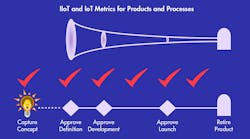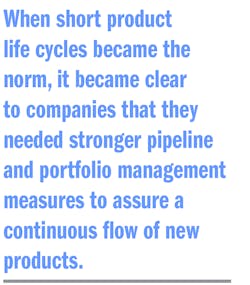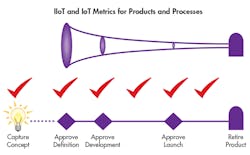Metrics for IoT in the Product Development Process
This file type includes high resolution graphics and schematics when applicable.
Metrics for product development were quite simple in the 1980s. Companies measured R&D spending, counted their patents, counted their projects, and the rest took care of itself in the era of long product life cycles. As life cycles began to shorten, a host of other metrics such as time-to-market and schedule slip became important.
In the 1990s, when advances in the science of managing R&D proved the importance of product requirements and definition to product success, new metrics for specification changes and degrees of conformance to requirements evolved to become part of everyday management.
When short product life cycles became the norm, it became clear to companies that they needed stronger pipeline and portfolio management measures to assure a continuous flow of new products. Industry started measuring the number of product concepts and quantified the expected revenue and profits from the project mix at every stage in the pipeline.
In the early 2000s, global competition became real and companies needed to further improve their process and product acumen. Measurement went to the next level of detail to assess raw technologies and capabilities that would underpin products of the future. As technology detail came into focus, so too did intellectual property (IP). IP both protects and enables the monetization of assets before (or in conjunction with) their being designed into products. Today it is hard to imagine product development metrics without measures that track concepts, requirements, technologies-in-process, pipeline dollar values, new product sales/profits, and IP licensing.
Improved IIoT and IoT Pipeline Processes
At least once every decade, advancements and stronger competition have necessitated the addition of measures to both drive and monitor progress. The advent of the Industrial Internet of Things (IIoT) and IoT will be no different. Let's look for a moment at a subset of the metrics that will arise in R&D and product development.
Most companies are still trying to get their arms around the implications of the IIoT and IoT on their product lines, and are focused on readying their strategies and processes. Many of these companies will wait to see what industry leaders are doing and then attempt to copy their approaches and the metrics that enable capabilities.
A recent literature scan we conducted turned up several companies that will likely be among the leaders that generate IoT-enabled product development processes and measures. Emerson Electric, Rockwell Automation, and General Electric appear to be out front at this time in systematizing the creation of IoT capabilities in product development. We expect that new-to-the-world metrics are evolving in these companies as well. However, to protect competitive advantages, it will be a few years yet before they are written up for public consumption.
Developing IIoT and IoT Metrics
Here is an idea of some of the types of metrics you might expect inside your company in the years ahead. In the areas of product architecture and modularity, expect metrics that rate product designs on their sensor-readiness, ability to receive and adjust to signals during manufacture and then in customer settings, and ability to generate data of customer value. In the areas of product planning and definition, expect metrics that assess the strength of the product to fit with the data gathering/producing/monitoring infrastructure of the differing markets and customer environments. In the areas of product design and development, expect metrics that assess the effectiveness, efficiency, and coverage of sensors in the product, along with new reliability measures for up-time and data error rates.
New metrics will also emanate from customers and marketplace(s). Customer satisfaction is sure to have several “IoT satisfaction” components. Research companies and market/investor analysts will likely develop comparative indices on the best IoT-enabled industries and companies.
We estimate some 50-plus metrics and measures will be developed in the decade ahead. Not all of them will gain traction. But, if history is our teacher, 10 years from now there will be another 10 to 15 new metrics that will be part of the everyday process of managing R&D and product development, along with a number of macro-indices in the marketplaces and investor communities.
This file type includes high resolution graphics and schematics when applicable.




